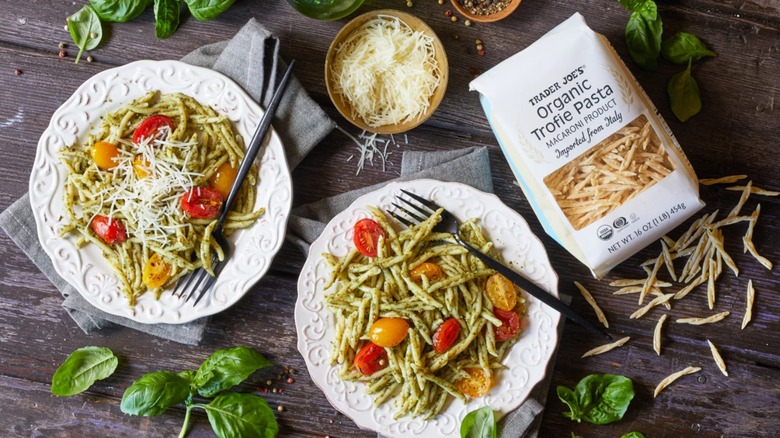Why Trader Joe's Shoppers Swear By Its Uniquely Shaped Trofie Pasta
One of the best kitchen staples to stock up on when making a Trader Joe's run has to be its dried pasta. The grocery store chain has a wide variety of different, high-quality pasta shapes that are reasonably priced and perfect to keep in the pantry for a quick lunch or dinner.
One style that many Trader Joe's fans swear by is its trofie pasta. Trofie (pronounced tro-fee-eh) is a small, twisted pasta noodle that is originally from Italy's Liguria region. At Trader Joe's you can get your hands on this high-quality organic pasta for just $1.99 per pound.
Trader Joe's says its pasta is made with 100% durum semolina wheat flour and made by die-cast extrusion. This is a process in which the pasta is pressed through a bronze extruder that gives it a superior consistency and texture. That texture will help hold onto whatever sauce you choose to serve with this quick-cooking pasta.
How to serve trofie pasta
One of the best parts about trofie pasta is its many nooks and crannies: Its twisted shape gives it an abundance of surface area and curves that help the sauce cling to its surface.
While a classic tomato sauce will always pair well with this pasta, the traditional choice is a pesto Genovese. Pesto may have Roman roots, but it was perfected by the Ligurians who also happen to invent trofie. This light sauce clings nicely to the pasta without producing so much that the smaller noodles are swimming around your bowl.
Really any lighter sauce will pair excellently with trofie. You don't want something as heavy as a ragù Bolognese because the noodles are too small to support the heavy chunks of meat. Instead, stick to an aglio e olio or cacio e pepe recipe. This pair has simple olive oil bases and doesn't have any large ingredients that would otherwise compete with or crush the trofie.
The art of making trofie at home
Obviously, it's easy enough to buy your own bag of trofie from Trader Joe's, but mastering the art of shaping pasta can also be a rewarding kitchen skill and will easily impress your guests.
The original method for shaping trofie allegedly involved the use of thin wooden knitting needles; the most common non-industrial method is to twist the pasta with your hands. In the highly technical method which accomplishes this, a pea-sized ball of pasta is taken and rolled forward on a wooden board to create a tapered cylinder. The hand then pulls in the opposite direction and twists the pasta as it returns.
It looks simple to the naked eye but belies the complex dexterity needed to make consistent shapes. Of course, if you don't want to go through all the trouble, Trader Joe's is still there for you.


